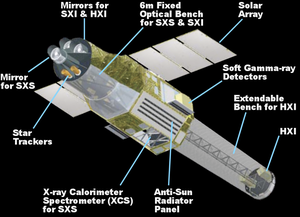Astro-H

Artist depiction of Hitomi
|
|||||||||||
| Names | ASTRO-H New X-ray Telescope |
||||||||||
|---|---|---|---|---|---|---|---|---|---|---|---|
| Mission type | X-ray astronomy | ||||||||||
| Operator | JAXA | ||||||||||
| COSPAR ID | 2016-012A | ||||||||||
| SATCAT no. | 41337 | ||||||||||
| Mission duration | Planned: 3 years Final: ≈37 days and 16 hours |
||||||||||
| Spacecraft properties | |||||||||||
| Launch mass | 2,700 kg (6,000 lb) | ||||||||||
| Dimensions | Length: 14 m (46 ft) | ||||||||||
| Power | 3,500 watts | ||||||||||
| Start of mission | |||||||||||
| Launch date | 17 February 2016, 08:45 UTC | ||||||||||
| Rocket | H-IIA 202, No. 30 | ||||||||||
| Launch site | Tanegashima Space Center, Japan | ||||||||||
| End of mission | |||||||||||
| Disposal | Destroyed | ||||||||||
| Destroyed | 26 March 2016, ≈01:42 UTC | ||||||||||
| Orbital parameters | |||||||||||
| Reference system | Geocentric | ||||||||||
| Regime | Low Earth | ||||||||||
| Semi-major axis | 6,948.6 km (4,317.7 mi) | ||||||||||
| Eccentricity | 0.0015 | ||||||||||
| Perigee | 559.85 km (347.87 mi) | ||||||||||
| Apogee | 581.10 km (361.08 mi) | ||||||||||
| Inclination | 31.01° | ||||||||||
| Period | 96 min | ||||||||||
| RAAN | 67.28° | ||||||||||
| Argument of perigee | 291.82° | ||||||||||
| Mean anomaly | 68.07° | ||||||||||
| Mean motion | 14.99 rev/day | ||||||||||
| Epoch | 27 March 2016, 17:27:54 UTC | ||||||||||
|
|||||||||||
| Instruments | |
|---|---|
| SXS | Soft X-ray Spectrometer |
| HXI | Hard X-ray Imager |
| SXI | Soft X-ray Imager |
| SGD | Soft Gamma-ray Detector |
Hitomi (Japanese: ひとみ?), also known as ASTRO-H and New X-ray Telescope (NeXT), was an X-ray astronomy satellite commissioned by the Japan Aerospace Exploration Agency (JAXA) for studying extremely energetic processes in the Universe. The space observatory was designed to extend the research conducted by the Advanced Satellite for Cosmology and Astrophysics (ASCA) by investigating the hard X-ray band above 10 keV. The satellite was originally called New X-ray Telescope; at the time of launch it was called ASTRO-H. After it was placed in orbit and its solar panels deployed, it was renamed Hitomi. The new name refers to the pupil of an eye, and to a legend of a painting of four dragons, two of which were given eyes and flew into the sky, and two that were left eyeless and stayed as motionless art. The spacecraft was launched on 17 February 2016 and contact was lost on 26 March 2016, due to multiple incidents with the attitude control system leading to an uncontrolled spin rate and breakup of structurally weak elements.
Hitomi's objectives were to explore the large-scale structure and evolution of the universe, as well as the distribution of dark matter within galaxy clusters and how the galaxy clusters evolve over time; how matter behaves in strong gravitational fields (such as matter inspiraling into black holes), to explore the physical conditions in regions where cosmic rays are accelerated, as well as observing supernovae. In order to achieve this, it was designed to be capable of:
It was the sixth of a series of JAXA X-ray satellites, which started in 1979, and it was designed to observe sources that are an order of magnitude fainter than its predecessor, Suzaku. Its planned mission length was three years. At the time of launch, two other large X-ray satellites were carrying out observations in orbit: the Chandra X-ray Observatory and XMM-Newton, both of which were launched in 1999.
...
Wikipedia
